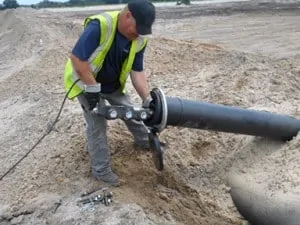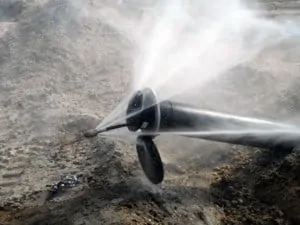

Removing biological growth in landfill leachate collection pipes is an important maintenance measure to keep the pipes in operable condition. High-pressure jet cleaning of the pipes on a regular schedule is performed in accordance with best practices and regulatory policy. For example, in Florida, solid waste rules require leachate collection pipes to be either jet cleaned every five years or videoed to confirm that the pipes are in operational condition. Of course, if the video shows that cleaning is necessary, the operator performs the maintenance and submits a report to the appropriate agency.
The spent jetting liquids contain a mix of calcite and microorganisms that have been removed from pipe walls and perforations. The liquid mixture flows to the lowest point in the pipe and enters the sump medium, which is typically composed of one to three-inch size rock. A drawback of jet cleaning is that when the pipes are cleaned, the spent jetting liquids enter the sump medium, thereby using essential leachate storage space in the sump. The calcite and microorganisms that were removed from the leachate piping are now present in the sump and will reduce the sump capacity and cause bottlenecks within the perforations in the riser pipe(s). Over time, this buildup will prevent the flow of leachate in the sump into the riser pipe. Without flow into the riser pipe, leachate removal from the sump becomes impossible, causing expensive operations and compliance issues for the landfill operator.
Clogging of the sump medium is a slow process; many sumps do not show indication of the impact of buildup for years. Landfill operators typically don’t use jet cleaning equipment equipped with vacuum features to remove the spent liquids from the pipe during cleaning. SCS recommends that this potential issue is discussed with the cleaning contractor in advance to account for the problems that can occur. For shallow landfills, contractors could provide a vacuum line inserted into the cleanout riser to remove the spent liquids as the pipe is cleaned. For deep landfills, the cleaning contractor can provide a temporary pump inserted inside the riser to remove the spent liquids.
To prevent excessive biological growth, jet cleaning of the riser pipes every time the leachate collection pipes are cleaned will significantly reduce clogging of the riser pipe perforations. Unmaintained riser pipes block leachate from entering the riser, preventing liquid removal and causing compliance issues when found.
Ask the author a question: Dr. Ali Khatama
The benefits of implementing these cleaning recommendations for leachate collection pipes will help keep the pipes clean and fully functioning; helping landfill operators prevent the potentially serious complications of clogged pipes and immovable leachate.
By Dr. Ali Khatami, P.E., SCS Engineers
Some states require that leachate collection pipes be cleaned with high-pressure jets on a regular basis (for example, every ten years or even more frequently); however, the rules don’t clarify or set forth the specific conditions under which the jet cleaning should be performed. Some landfills have undertaken jet cleaning while the pipes are partially or fully submerged in leachate above the liner. Unfortunately, jetting under water may drastically reduce the effectiveness of the pressurized jet, resulting in a pipe that is not cleaned properly. This is even more important when the jetting is intended to remove biological growth on the pipe walls and in the perforation openings.

In addition, many states do not require videotaping the pipe after jetting. Videotaping is the best way to verify that the pipe was cleaned successfully. If the leachate collection pipes are not properly cleaned, then over a period of 20 years or so, they can be adversely impacted by severe biological growth and buildup in the pipe perforations to the point that liquid can no longer enter the pipe.
Another shortcoming is that the rules do not specifically require that the riser pipes (where the submersible pumps are located) be cleaned or videotaped. Therefore, due to the added costs, some landfill operators may not clean the riser pipes as part of the required cleaning events, or they may delay such cleanings for an extended period. This can prevent leachate from flowing into the riser with the direct and serious consequence that leachate cannot be removed from the sump.

Another issue to consider is that pressurized jet cleaning procedures do not necessarily push the solids that separate from the pipe wall out of the pipe inlet opening through which the cleaning nozzle entered the pipe. As a result, these solids flow out of the pipe and into the gravel bedding on the outside of the pipe, and can potentially clog the void within the gravel pack around the pipe or in the sump. Clogging the sump gravel can mean reduced flow capacity from the leachate collection pipe to the riser pipe and the submersible pumps.
To resolve these issues, SCS recommends the following:
The benefits of implementing these recommendations will help keep the pipes clean and fully functioning. These suggestions help prevent potentially serious complications that the landfill operator may have to address if the pipes are clogged and leachate cannot be removed.
Questions? Contact Ali Khatami, PhD, PE, LEP, CGC, is a Project Director and a Vice President of SCS Engineers. He is also our National Expert for Landfill Design and Construction Quality Assurance. He has nearly 40 years of research and professional experience in mechanical, structural, and civil engineering. Dr. Khatami has acquired extensive experience and knowledge in the areas of geology, hydrogeology, hydrology, hydraulics, construction methods, material science, construction quality assurance (CQA), and stability of earth systems. Dr. Khatami has applied this experience in the siting of numerous landfills and the remediation of hazardous waste contaminated sites.